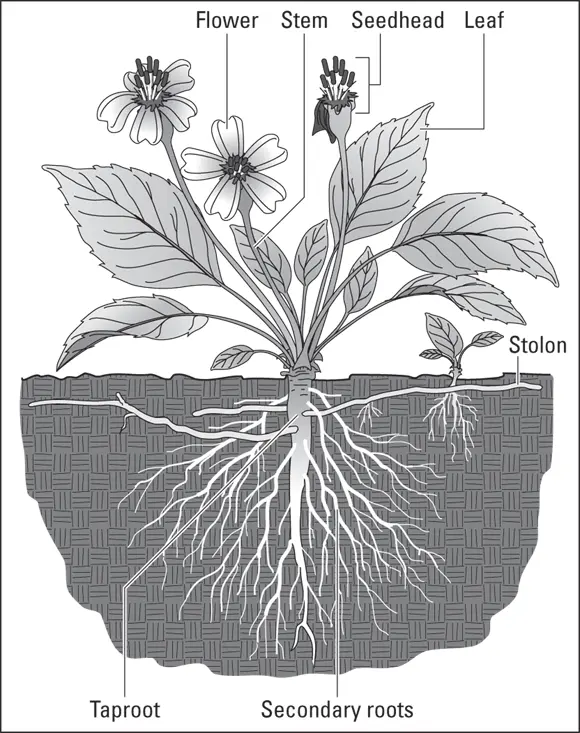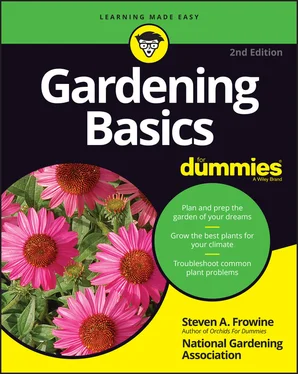The biggest problem with common names is that the same plant can have many different common names depending on what part of the United States or the world you live in.
Anatomy 101: Naming plant parts
Beyond recognizing the names of plants, knowing the various parts of plants is also useful. Figure 1-1 shows a nice, healthy perennial plant with the basic parts displayed. Botanists use many more descriptive and detailed names for plant parts, but you have enough to remember without getting further confused! You probably already know most of the common ones, but keep these parts in mind, because you need to know them to understand some of the things I discuss in the rest of this book and to speak the language with fellow gardeners. In the figure, the taproot (not all plants have this) is the main root of the plant; the stolon, or runner, is a horizontal stem that spreads underground, sending up more plants as it goes; many groundcovers (pachysandra, ivy, ice plant) operate this way, as anyone who has tried to tug up a patch well knows!
 Propagate is a term commonly used in horticulture to describe the process of reproducing or multiplying plants. I discuss it more detail in Chapter 10.
Propagate is a term commonly used in horticulture to describe the process of reproducing or multiplying plants. I discuss it more detail in Chapter 10.
When you know the parts of plants and the difference between all the plant names you run into, you may be ready to get the lowdown on the types of plants out there!

© John Wiley & Sons, Inc.
FIGURE 1-1:The basic parts of a perennial plant, above and below ground.
Beautifying with Flowers (and Foliage)
Flowers are often the first thing that comes to mind when people think of gardening and the first thing people plan to grow when they want to beautify their surroundings. Flowers are marvelous because they come in a vast array of sizes, colors, and shapes (see Figure 1-2), and no matter where you live, at least one kind of flowering plant can grow there. Even the volcanic crater of Haleakala, on the island of Maui, is home to a flowering plant: the rare silver sword.
Flowers are more than merely the beautiful display they put on, however. If you know the different types of flowers out there, you can take full advantage of displaying them in your own garden. Read on for info on annuals and perennials, as well as a bit on bulbs and roses.
You may already know what annuals are without realizing that you know! These beauties are the flowers, arrayed in flats and pots, for sale every spring down at the garden center — everything from geraniums to impatiens to marigolds. You bring them home and plunk ’em in the ground, and they get right to work, delivering pretty much continuous color all summer long. When fall comes, they start to slow down (some may even go to seed); cold weather eventually causes them to wither and die. Game over. (That is, unless you live in a frost-free climate; in this case, your “annuals” may become perennials. See the section, “ Perennial plants,” later in this chapter for more information.)

© John Wiley & Sons, Inc.
FIGURE 1-2:Flowers come in a wide variety of sizes and shapes.
For the brief time annuals are growing and pumping out flowers, you get a lot of bang for your buck. A great deal of selection and breeding refinements over the years have made these plants totally reliable. They’re full of exuberant energy and hard to kill. Indeed, some of them keep blooming their cheery heads off even when you neglect them. They provide reliable garden color even as perennials cycle in and out of bloom.
Some gardeners have been known to sneer at good old annuals. They’re boring. They’re too perky. They’re “plastic plants.” These folks may or may not have a point, but hey, annuals are hard to beat if you want a colorful garden.
In the end, the main drawback of annuals is economic. You have to buy new ones every spring. If you’re planting a wide area, running out to buy more year in and year out can get expensive. Time may also be an issue for you — you may grow sick and tired of getting down on your hands and knees and replanting. (If you’re getting to that point, consider a longer-term investment, planting perennials.)
You can use annuals
To fill an entire flowerbed (this popular use is why some places call annuals bedding plants )
To add to container displays — in pots, window boxes, patio planter boxes, and more
To fill a hanging basket
To edge a walkway
To insert reliable color in a perennial bed
To decorate a vegetable and herb garden
To cover over or at least distract from a fading spring bulb display
To add summer color to your flower beds when the perennials are done blooming
To fill in places where perennial plants haven’t filled in yet — the added advantage of covering ground so opportunistic weeds can’t move in
If the info you want on annuals isn’t in the upcoming sections, you can get an in-depth look in Chapter 6.
Caring for and feeding annuals
Luckily, taking proper care of annuals is not rocket science. For the most part, annuals are easygoing, because they’re bred to be quite tough and durable. Many can withstand some neglect and still be productive — not that I recommend ignoring them!
 Without a doubt, water is an annual’s number one need. All that lusty growth and continuous flowering requires fuel. A thirsty plant can’t sustain the show for long. Regular, deep soakings are best because they reliably supply water to the roots, which leads to a stress-free life of consistent growth and bud and bloom production. (Note that a drying-out plant favors its roots and, to a lesser extent, its leaves, in a bid for survival, automatically jettisoning its water-hogging buds and petals.) Note that annuals grown in pots, hanging baskets, or window boxes dry out much faster than ones grown in the ground. See Chapter 4for more info on watering.
Without a doubt, water is an annual’s number one need. All that lusty growth and continuous flowering requires fuel. A thirsty plant can’t sustain the show for long. Regular, deep soakings are best because they reliably supply water to the roots, which leads to a stress-free life of consistent growth and bud and bloom production. (Note that a drying-out plant favors its roots and, to a lesser extent, its leaves, in a bid for survival, automatically jettisoning its water-hogging buds and petals.) Note that annuals grown in pots, hanging baskets, or window boxes dry out much faster than ones grown in the ground. See Chapter 4for more info on watering.
You can’t deny that regular doses of plant food or fertilizer significantly boost your annuals (make sure you apply it according to directions). For best flowering fertilize every six weeks with a granular or organic fertilizer or add a water-soluble fertilizer to your sprinkling can every week or so. The leaves become healthier and greener, and you end up with more buds and flowers. Chapter 4contains information on fertilizer as well.
The rather unromantic term of deadheading simply refers to the practice of pinching or cutting off spent flowers. Your annuals look nicer when you do this, of course, but removing the flowers also serves another purpose: It thwarts the plant from the energy-intensive process of producing seeds, and the plant responds by diverting its energy back into making more flowers.
Raising annuals from seed
Of course, you can raise annuals from seed, which is the most economical approach, especially if you want to grow large quantities for a display garden. Some are simpler to grow than others. Annuals with very small seeds like snapdragons and begonias are a bit more of a challenge because you need to start them indoors in a bright windowsill or under fluorescent lights.
Читать дальше

 Propagate is a term commonly used in horticulture to describe the process of reproducing or multiplying plants. I discuss it more detail in Chapter 10.
Propagate is a term commonly used in horticulture to describe the process of reproducing or multiplying plants. I discuss it more detail in Chapter 10.












